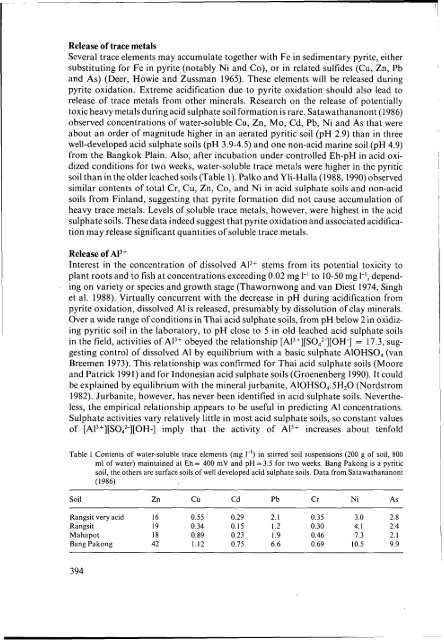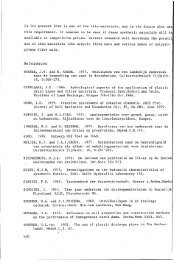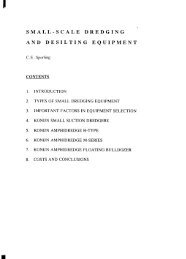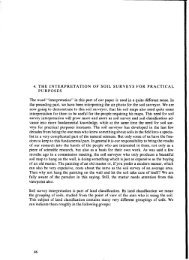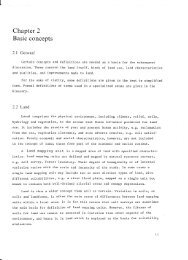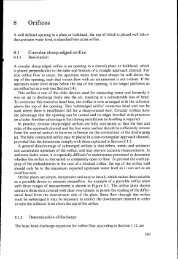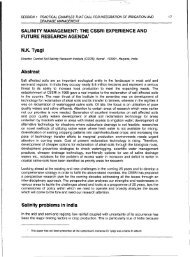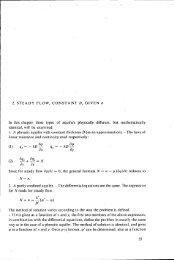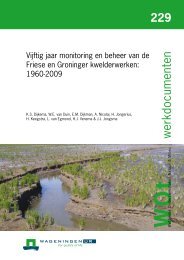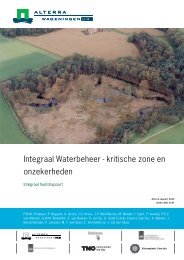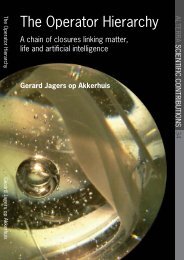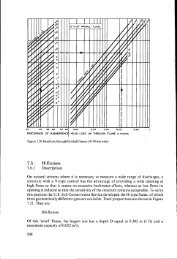Environmental aspects of acid sulphate soils - ROOT of content
Environmental aspects of acid sulphate soils - ROOT of content
Environmental aspects of acid sulphate soils - ROOT of content
You also want an ePaper? Increase the reach of your titles
YUMPU automatically turns print PDFs into web optimized ePapers that Google loves.
Release <strong>of</strong> trace metalsSeveral trace elements may accumulate together with Fe in sedimentary pyrite, eithersubstituting for Fe in pyrite (notably Ni and Co), or in related sulfides (Cu, Zn, Pband As) (Deer, Howie and Zussman 1965). These elements will be released duringpyrite oxidation. Extreme <strong>acid</strong>ification due to pyrite oxidation should also lead torelease <strong>of</strong> trace metals from other minerals. Research on the release <strong>of</strong> potentiallytoxic heavy metals during <strong>acid</strong> <strong>sulphate</strong> soil formation is rare. Satawathananont (1986)observed concentrations <strong>of</strong> water-soluble Cu, Zn, Mo, Cd, Pb, Ni and As that wereabout an order <strong>of</strong> magnitude higher in an aerated pyritic soil (pH 2.9) than in threewell-developed <strong>acid</strong> <strong>sulphate</strong> <strong>soils</strong> (pH 3.9-4.5) and one non-<strong>acid</strong> marine soil (pH 4.9)from the Bangkok Plain. Also, after incubation under controlled Eh-pH in <strong>acid</strong> oxidizedconditions for two weeks, water-soluble trace metals were higher in the pyriticsoil than in the older leached <strong>soils</strong> (Table 1). Palko and Yli-Halla (1988,1990) observedsimilar <strong>content</strong>s <strong>of</strong> total Cr, Cu, Zn, Co, and Ni in <strong>acid</strong> <strong>sulphate</strong> <strong>soils</strong> and non-<strong>acid</strong><strong>soils</strong> from Finland, suggesting that pyrite formation did not cause accumulation <strong>of</strong>heavy trace metals. Levels <strong>of</strong> soluble trace metals, however, were highest in the <strong>acid</strong><strong>sulphate</strong> <strong>soils</strong>. These data indeed suggest that pyrite oxidation and associated <strong>acid</strong>ificationmay release significant quantities <strong>of</strong> soluble trace metals.Release <strong>of</strong> + Al3Interest in the concentration <strong>of</strong> dissolved Al3+ stems from its potential toxicity toplant roots and to fish at concentrations exceeding 0.02 mg I-' to 10-50 mg I-', dependingon variety or species and growth stage (Thawornwong and van Diest 1974, Singhet al. 1988). Virtually concurrent with the decrease in pH during <strong>acid</strong>ification frompyrite oxidation, dissolved AI is released, presumably by dissolution <strong>of</strong> clay minerals.Over a wide range <strong>of</strong> conditions in Thai <strong>acid</strong> <strong>sulphate</strong> <strong>soils</strong>, from pH below 2 in oxidizingpyritic soil in the laboratory, to pH close to 5 in old leached <strong>acid</strong> <strong>sulphate</strong> <strong>soils</strong>in the field, activities <strong>of</strong> Al3+ obeyed the relationship [A13+][S0,2-][OH-] = 17.3, suggestingcontrol <strong>of</strong> dissolved Al by equilibrium with a basic <strong>sulphate</strong> AIOHSO, (vanBreemen 1973). This relationship was confirmed for Thai <strong>acid</strong> <strong>sulphate</strong> <strong>soils</strong> (Mooreand Patrick 1991) and for Indonesian <strong>acid</strong> <strong>sulphate</strong> <strong>soils</strong> (Groenenberg 1990). It couldbe explained by equilibrium with the mineral jurbanite, A10HS0,.5H20 (Nordstrom1982). Jurbanite, however, has never been identified in <strong>acid</strong> <strong>sulphate</strong> <strong>soils</strong>. Nevertheless,the empirical relationship appears to be useful in predicting AI concentrations.Sulphate activities vary relatively little in most <strong>acid</strong> <strong>sulphate</strong> <strong>soils</strong>, so constant values<strong>of</strong> [AI3+][S0,2-][OH-] imply that the activity <strong>of</strong> Al3+ increases about tenfoldTable 1 Contents <strong>of</strong> water-soluble trace elements (mg I-') in stirred soil suspensions (200 g <strong>of</strong> soil, 800ml <strong>of</strong> water) maintained at Eh= 400 mV and pH=3.5 for two weeks. Bang Pakong is a pyriticsoil, the others are surface <strong>soils</strong> <strong>of</strong> well developed <strong>acid</strong> <strong>sulphate</strong> <strong>soils</strong>. Data from Satawathananont(I 986)Soil Zn Cu Cd Pb Cr Ni AsRangsit very <strong>acid</strong> 16 0.55 0.29 2. I 0.35 3.0 2.8Rangsit 19 0.34 0.15 I .2 0.30 4. I 2.4Mahapot 18 0.89 0.23 I .9 0.46 7.3 2. IBangPakong 42 1.12 0.75 6.6 0.69 10.5 9.9394


